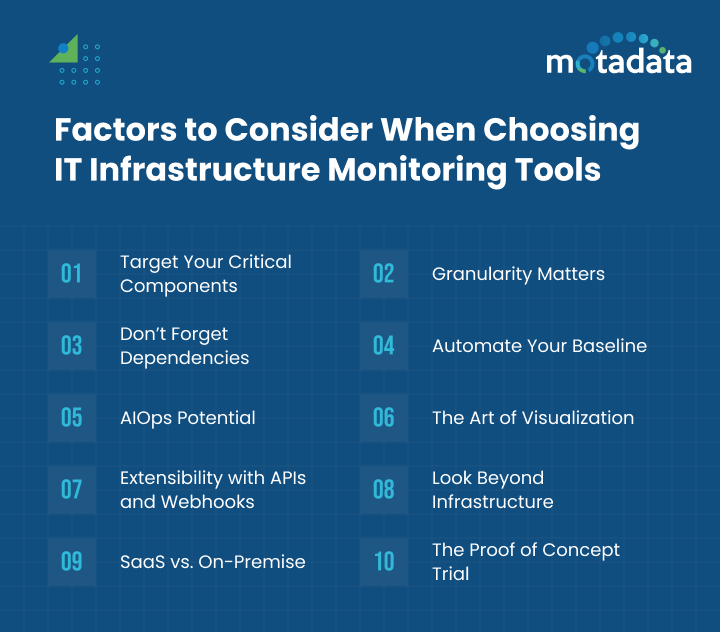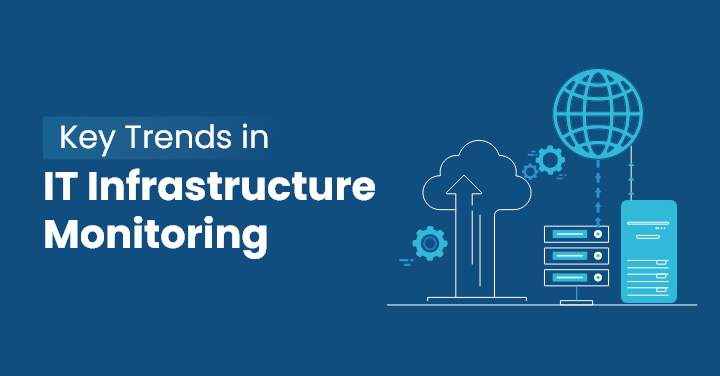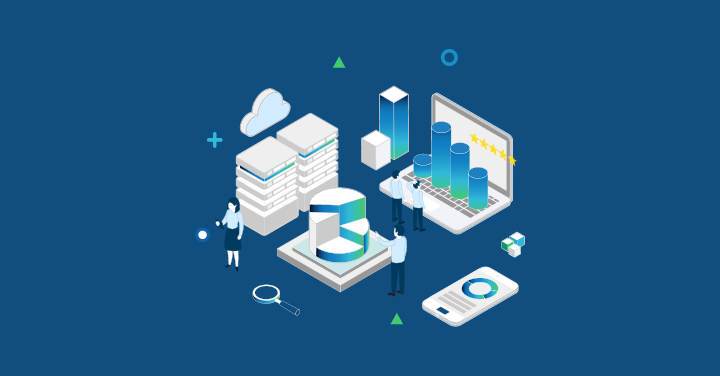In today’s time, most businesses use cloud-native technologies and digital infrastructure to stay ahead of their competitors.
The excessive dependency on these technologies is resulting in a distributed IT infrastructure that is quite challenging to manage and grow without the right tools and practices.
Ensuring proper health and performance of IT infrastructure is crucial to achieving organizational goals and keeping end-users satisfied. This is where infrastructure Monitoring comes into practice.
Infrastructure Monitoring is a process used by IT professionals to drive business value and outcomes by collecting and analyzing performance data from different backend sources.
With the help of these insights related to IT infrastructure, systems, and processes, businesses can resolve performance issues faster and make better decisions.
Let us understand more about the importance of IT infrastructure Monitoring tools and factors one must consider when selecting for their business.
Why is an Infrastructure Monitoring Tool Important?
With everything going digital and excessive use of cloud services, you need to be careful with your systems and processes at all times.
Even a minor fault in the application, server, or network device can impact your customer experience.
Instead, they must take a proactive stance in order to spot and fix such infrastructure problems before they have an adverse effect on user experience.
With infrastructure monitoring, businesses can achieve this goal as it accelerates the process of root cause analysis and incident response.
Further, organizations can constantly monitor the patterns and trends in real time and know which areas require attention and optimization. Also, the tool flags potential issues at an early stage which reduces downtime.
From performance optimization to detecting abnormalities in a system, infrastructure monitoring tools cover all.
The tool even provides detailed insights into resource utilization that help businesses make informed decisions related to capacity planning and cost management.
Be it server monitoring, Application performance monitoring, cloud monitoring, network monitoring, log management, or configuration management, the management tool covers it all.
Another reason why implementing infrastructure monitoring for businesses is crucial is it identifies security breaches in real time and helps take appropriate measures for infrastructure safety.
Overall, with the incorporation of this infrastructure monitoring tool, you can maintain stability, performance management, and look after the security of your IT environment.
Factors to Consider When Choosing IT Infrastructure Monitoring Tools
For your company’s IT assistance, you can rely on outsourced technical support, but it could be useful to know how to choose an appropriate monitoring solution.
With the assistance of an IT monitoring tool, you can identify problems early on and take immediate action to resolve them.
But with so many options available, it might be challenging to choose a monitoring solution that fits your needs.
Let us go through the factors you need to think about when selecting an IT monitoring solution:
1. Target Your Critical Components:
Make sure to check if your selected IT Infrastructure Monitoring solution is capable enough to identify and prioritize the critical components of your infrastructure.
Legacy systems are one of the key components that might have turned outdated but are still used by professionals for day-to-day operations.
Hence, it is crucial to check if the infrastructure monitoring tool can track all the potential vulnerabilities and compatibility issues in outdated systems.
Also, it can track the cloud-native microservices and their metrics like throughput, error rates, and service availability in real-time, ensuring optimal performance.
Apart from these, there are several other crucial components in an IT infrastructure that if compromised can impact overall business operations.
These include network infrastructure, databases, and third-party integrations. By prioritizing each of these components, businesses can better allocate resources, reduce risk, and improve performance rates.
2. Granularity Matters:
Another key factor to look for in an IT infrastructure Monitoring software is an in-depth visibility feature.
Ensure whether it allows you to keep track of the system and processes to a certain limit, i.e., just monitoring if a system is up and running or if it’s down.
Or it allows you to monitor all the performance metrics, i.e., CPU usage, memory leaks, performance bottlenecks, and other in-depth insights.
The information you require to make decisions about your systems will determine the appropriate level of granularity. If you need to perform basic analysis, simple checks would be enough.
However, if you want to run a detailed analysis of the infrastructure, systems, and processes, you might need a tool that provides detailed insights for better decision-making.
3. Don’t Forget Dependencies:
In a complex IT environment, there are multiple applications, systems, and network devices that are connected to one another and depend on each other for smooth operations.
In the IT environment, a fault in a single system can halt the functioning of other operations.
For example, if there is a fault in the server, the customer won’t be able to access the application unless the fault is fixed.
Hence, invest in an infrastructure Monitoring tool that eases your tasks of understanding and mapping out these dependencies.
It will ease the whole process of understanding how each part of the system affects the other.
Further, with this feature, IT teams will be easily able to identify the root cause of a problem and come up with an appropriate solution in real time.
There are several benefits of the dependency mapping feature in a monitoring tool so make sure you have it in yours too.
4. Automate Your Baseline:
Look for a solution that uses cutting-edge technologies like statistical analysis and machine learning to make it easy to identify trends in the operation of your system.
It determines factors like how much data your servers usually process, how frequently you use your apps, and how quickly information moves over your network.
With this feature in your tool, you can detect abnormalities or unusual patterns automatically once it has a firm understanding of what is normal.
The program will raise an alert, for example, if there’s an unexpected reduction in network speed or a rapid spike in server activity.
You can take care of problems with this early warning system before they become serious disruptions.
It’s similar to having an assistant monitoring your systems and notifying you of any strange activity so you can respond quickly and maintain system stability.
5. AIOps Potential:
Try to go in for a monitoring system that involves leveraging AI and machine learning technologies as it will ease your overall task as well as generate insightful data.
AIOps-enabled tools are the game-changers as they ensure effective IT operations, and quick alert responses as well as ensure there is minimal to zero downtime in your business.
Further, they have the capability to correlate events across your entire stack and perform self-healing actions.
For example, with these tools, you can track spikes or unusual patterns in a real-time and take the right measures accordingly.
Overall, investing in a tool with AIOps capabilities can reduce your team’s workload as it will automate repetitive tasks, reduce manual errors, identify the root cause of an issue, and recommend suggestions for quick issue resolution.
6. The Art of Visualization:
Investing in monitoring platform that provides a basic dashboard to view all the data and reports isn’t enough. Instead look for an modern infrastructure Monitoring software that transforms your raw data into insightful reports with graphs, charts, and diagrams.
These visualization features help users identify trends, patterns, and anomalies faster.
Also, it supports tracking how each metric has performed over a period, thus making it easier to predict future trends.
By prioritizing clear visualizations along with historical data tracking, users can effectively monitor their IT operations and ensure better performance delivery.
7. Extensibility with APIs and Webhooks:
It’s important for businesses to first understand whether they are in need of other third-party tools or not.
For example, features like alerts to your incident management systems or workflows that are automatically started based on data from monitoring are necessary.
If you believe there is a need for third-party tools then it is essential to look for a solution that offers seamless integration with other systems and workflows.
Try to go for software with robust APIs and webhook capabilities as it will ease your entire infrastructure monitoring process and enhance operational efficiency.
8. Look Beyond Infrastructure:
Another important factor that one must not miss when evaluating a monitoring tool for IT infrastructure and processes is the ability to monitor end-user experience metrics.
Apart from assessing the health of systems, the tool must also be capable enough to track and analyze how users behave and interact with your services and applications.
This feature is becoming highly crucial as even a delay in incident response or fault in the server can impact actual users and cause reputational damage.
So, look a little beyond infrastructure and include end-user experience metrics for a better understanding of system performance.
9. SaaS vs. On-Premise:
You should carefully consider the benefits and drawbacks of both options before choosing between an on-premise solution and a Software-as-a-Service (SaaS) model for your IT infrastructure monitoring needs.
For a large environment, you might prefer going with the on-premise tools as it provides improved disaster recovery capabilities and allows you more control over security.
Your system administrators, however, need technical know-how because they will be handling everything.
Smaller environments might find SaaS-based monitoring tools suitable since the management is handled, and system administrators don’t have to worry about it.
Additionally, because only the services utilized are paid for, the costs are comparatively lower.
It’s similar to having reasonably priced remote IT infrastructure configuration capabilities. However, your control over security will be reduced.
The choice between an on-premise solution and a SaaS model ultimately comes down to organizational requirements, budgetary constraints, security posture, and IT resource allocation.
Hence, analyze all the parameters and determine the most suitable option accordingly.
10. The Proof of Concept Trial:
Lastly, make sure to invest in a tool that offers free trials or demo sessions to test its features and functionalities.
Conducting a proof of concept trial allows businesses to better evaluate the performance and capabilities of the team and if it will meet the business requirements in the long run.
Also, it allows users to assess how well it will manage their data volumes and unique configurations.
This feature will surely help you make an informed decision based on the evidence and experience gathered from its use.
Conclusion
More than ever, your IT infrastructure needs to be carefully considered in relation to the end user and organisation.
With businesses adopting more and more cloud-native technologies, it is essential to look into all the systems and processes in real-time to minimize downtime and improve productivity.
A wise investment in infrastructure monitoring is the only way to get observability into performance, which is critical across the IT stack.
To make sure that your business operates smoothly and effectively, it is essential to select the appropriate solutions for IT infrastructure management and monitoring.
You can make sure that you are constantly one step ahead of possible problems by taking the time to completely comprehend your needs, carefully choosing the tools that best suit those needs, and putting thorough monitoring and fast response tactics into practice.
Above we have listed some of the common factors to consider when selecting the best IT infrastructure monitoring tool for your organization.
There are several tools like ManageEngine OpManager, New Relic, etc., available in the market which makes the whole task of choosing the right tool a bit challenging and complex.
Motadata Infrastructure monitoring tool is one such tool that meets all the above-mentioned features and functionalities.
It is an AI-driven observability platform that allows IT admins to track all the cloud services, networks, devices, event logs, and virtual machines from a single console.
The tool provides in-depth visibility into the entire stack and alert features that aid in improving Infrastructure performance and delivering better business outcomes.
You can even try the free trial with a click.
FAQs
There are several features that one can choose from but we have shortlisted a few that are key elements and one must not miss.
AIOps capabilities, dependency mapping, automation, real-time monitoring, deployment flexibility, API support, granular monitoring, and free trials are a few key features that an IT professional must surely look for in an IT infrastructure Monitoring tool.
These features altogether will enhance your performance, reduce downtime, and improve overall efficiency.
To get the most out of an infrastructure monitoring tool, it must have an easy-to-use interface and intuitive user experience. To improve usability and facilitate quicker team collaboration, troubleshooting, and decision-making, customizable dashboards with clear representations and optimized workflows are implemented.
The cost of deployment models (SaaS vs. on-premise), licensing fees, scalability, support and maintenance expenses, integration requirements, and the total cost of ownership over the tool’s lifecycle should all be taken into account when assessing the cost of infrastructure monitoring tools.
It is also important to consider the tool’s value proposition, which includes increased performance, decreased downtime, and improved operational efficiency.








